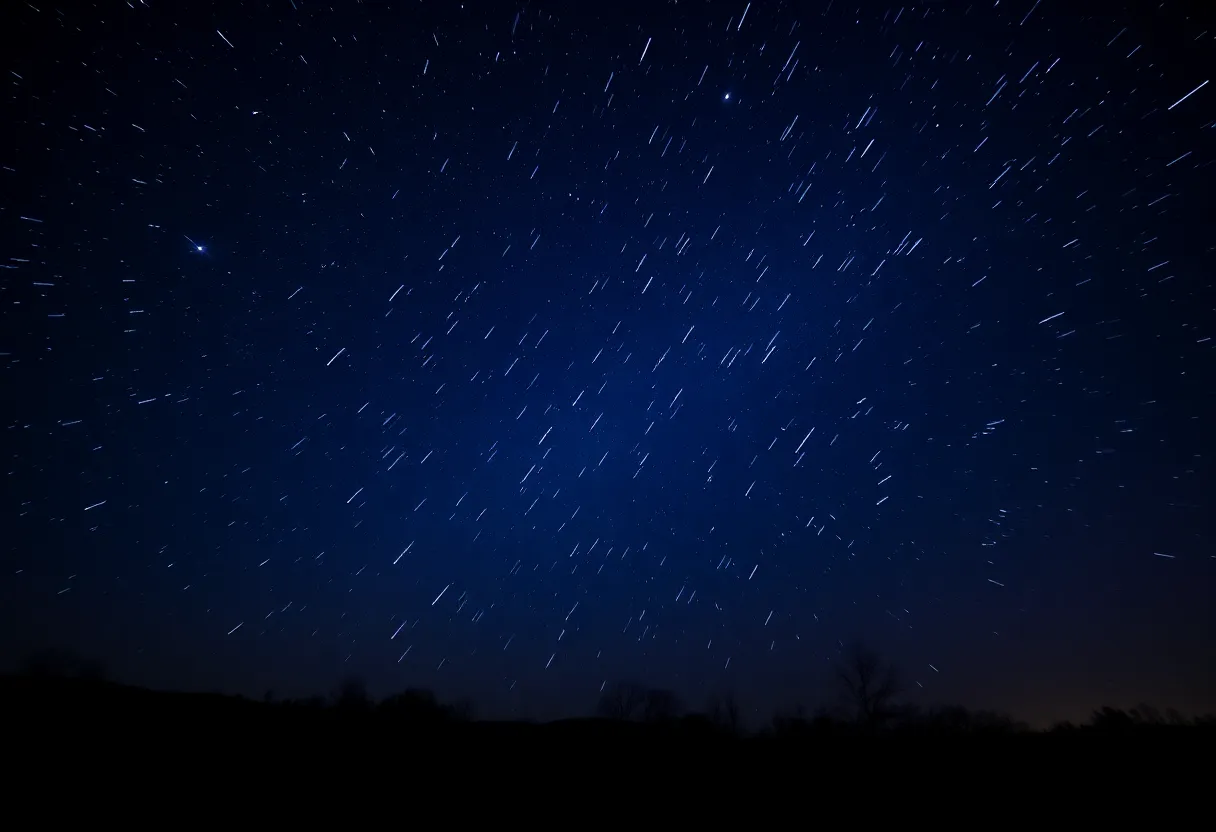Louisville, October 21, 2025
The Orionid meteor shower reaches its peak tonight, offering a breathtaking display for Louisville residents. This annual event allows for optimal viewing after midnight, particularly in darker areas away from city lights. Astronomers recommend locations like Bernheim Arboretum for the best experience. The celestial phenomenon is caused by debris from Halley’s Comet. Families are encouraged to dress warmly and gather outdoors to witness this awe-inspiring event, which is expected to produce up to 20 meteors per hour under ideal conditions.
Orionid Meteor Shower Peaks Over Louisville
Louisville, KY – The Orionid meteor shower reaches its peak tonight, October 21, 2025, providing a spectacular celestial event for local residents. This annual phenomenon offers clear viewing opportunities after midnight under favorable weather conditions, making it a highlight for skywatchers in the area.
The shower is visible in Louisville‘s clear skies, with the best chances for observation starting late at night. Debris from Halley’s Comet creates the meteors, which streak across the sky as Earth passes through the comet’s trail. Astronomers suggest seeking out darker locations to enhance the experience, as urban lights can obscure the display.
For optimal viewing, experts from the University of Louisville recommend visiting spots like Bernheim Arboretum. These areas provide darker skies away from city glow, allowing for a clearer and more immersive sight. The event is free and accessible, encouraging families to participate by preparing for cooler temperatures with appropriate clothing.
Supporting details from recent observations indicate that the Orionids can produce up to 20 meteors per hour at their peak, though actual numbers may vary based on atmospheric conditions. In Louisville, the shower’s timing aligns with the early morning hours, giving residents a window from midnight onward to catch the streaks of light. Clear skies are essential, as cloud cover could diminish visibility, so checking local weather forecasts is advisable.
Background on the Orionid meteor shower reveals it as a recurring event tied to the orbit of Halley’s Comet. This comet, which last passed near Earth in 1986, leaves behind a stream of particles that the planet encounters annually. The meteors appear to radiate from the constellation Orion, hence the name, and the shower typically occurs in October. In Louisville, this marks a popular seasonal attraction, drawing interest from both amateur stargazers and families looking for outdoor activities.
While the peak occurs tonight, the shower may remain visible for several days afterward, though with reduced intensity. This event underscores the natural beauty of the night sky and serves as a reminder of celestial mechanics at work. No special equipment is needed for basic viewing, but binoculars or telescopes can enhance the experience for those interested in finer details.
Local experts emphasize safety and preparation, advising viewers to dress warmly and choose safe, dark locations. The Orionid meteor shower not only offers entertainment but also an educational opportunity, allowing people to connect with astronomical phenomena in a hands-on way. As night falls, Louisville residents have a prime chance to witness this cosmic display, fostering a sense of wonder about the universe.
Expanding on the event’s significance, the Orionids are part of a broader pattern of meteor showers throughout the year, each linked to different cometary sources. In this case, the connection to Halley’s Comet adds historical context, as the comet has been observed for centuries. For Louisville, this peak provides a communal activity that can be enjoyed from various vantage points, including parks and rural outskirts.
Further details include the shower’s speed, with meteors traveling at about 41 miles per second, creating bright trails in the sky. This year’s viewing in Louisville is expected to be particularly clear, based on recent patterns, making it an ideal time for community engagement. Astronomers continue to monitor such events to provide updates, ensuring that the public stays informed about optimal viewing times.
In summary, tonight’s peak of the Orionid meteor shower in Louisville promises a memorable experience for all ages. By following simple guidelines, residents can make the most of this natural spectacle, appreciating the wonders of the night sky from their local area.
FAQ Section
- Q: When does the Orionid meteor shower peak in Louisville?
A: The Orionid meteor shower peaks tonight over Louisville, offering residents a stunning celestial display. - Q: When is the Orionid meteor shower visible in Louisville?
A: Visible after midnight in clear skies. - Q: What causes the Orionid meteor shower?
A: The event draws from Halley’s Comet debris. - Q: What do astronomers at the University of Louisville recommend for viewing?
A: Astronomers at the University of Louisville recommend heading to dark spots like Bernheim Arboretum for optimal viewing. - Q: Who is encouraged to view the Orionid meteor shower in Louisville?
A: Families are encouraged to bundle up and enjoy the free show.
Key Features Chart
| Feature | Description |
|---|---|
| Peak Date | October 21, 2025 |
| Visibility Time | After midnight in clear skies |
| Source | Halley’s Comet debris |
| Recommended Location | Dark spots like Bernheim Arboretum |
| Audience | Families encouraged to bundle up |
| Cost | Free show |





